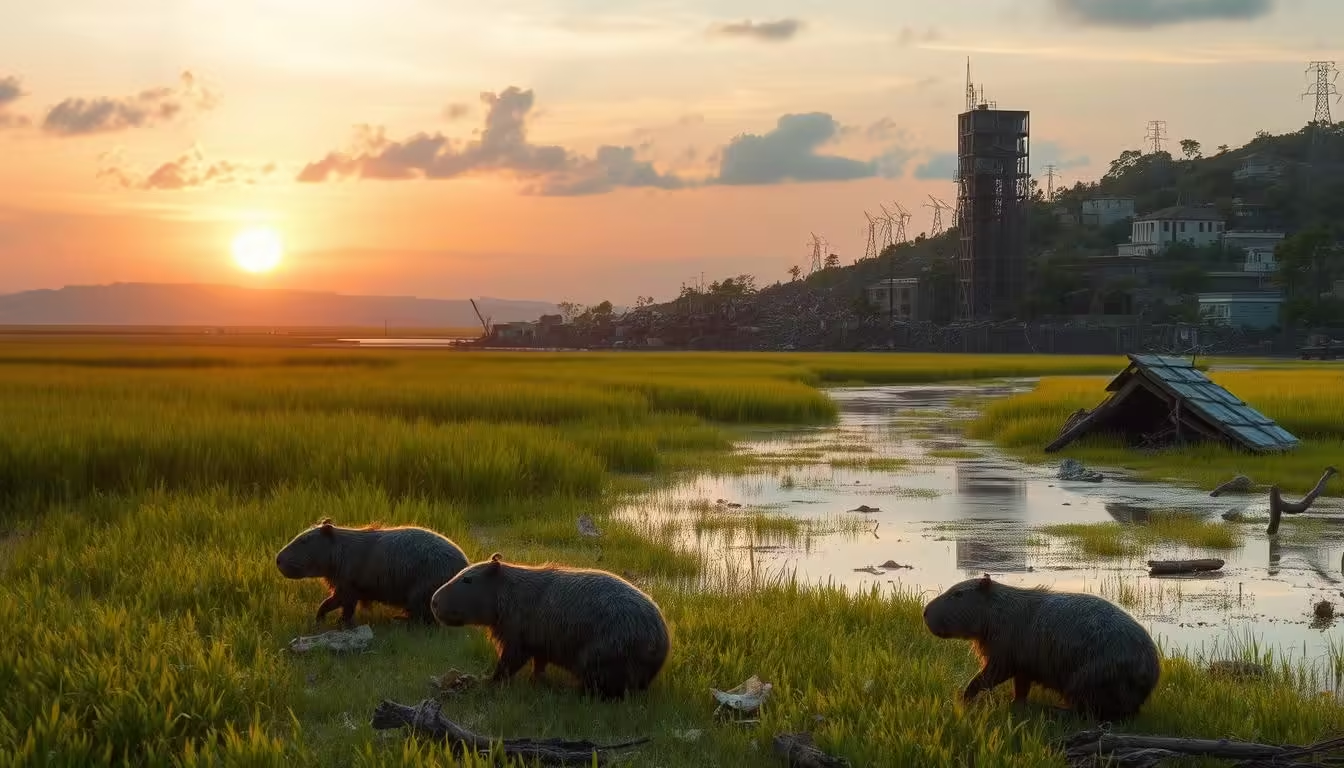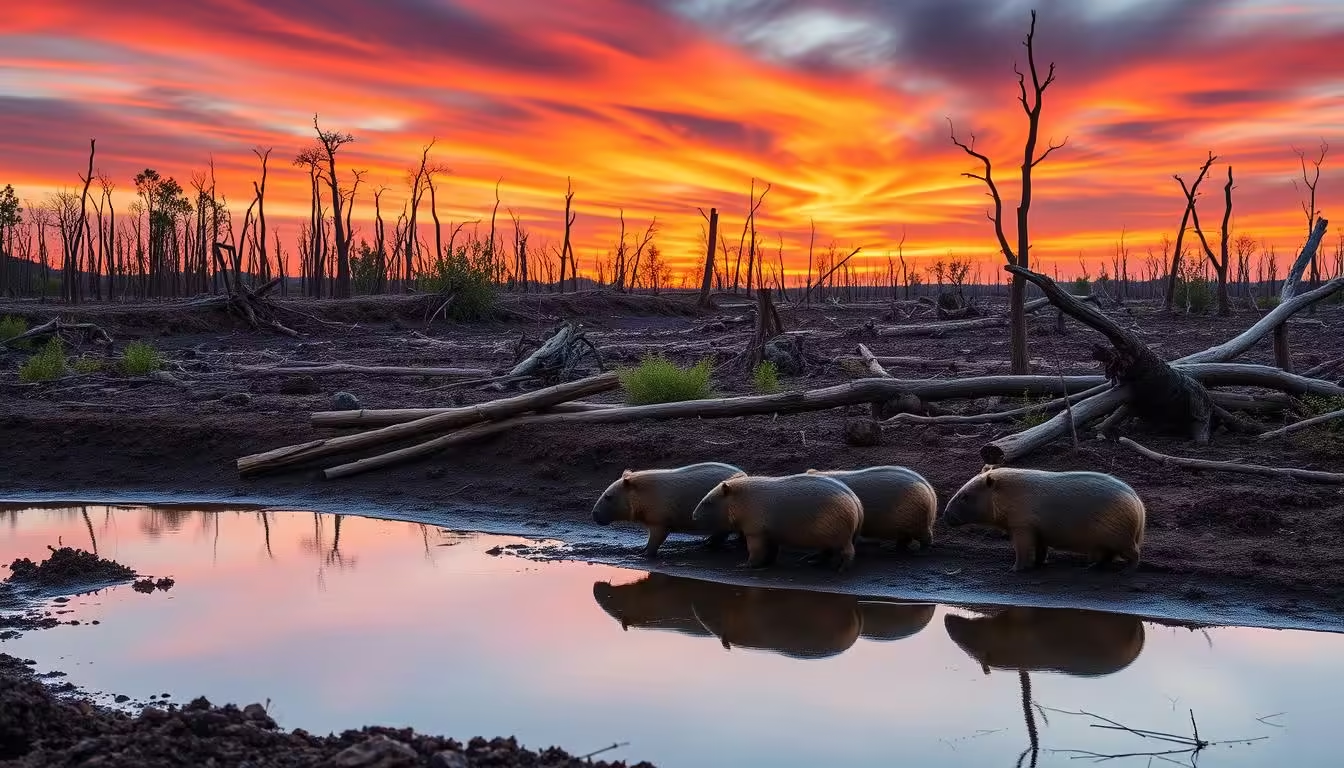In South America, capybara numbers are growing in dry areas. This makes it hard to restore habitats. The reason is the change from forests to croplands and pastures. This creates new homes for the world’s biggest rodent.
Even though more capybaras might seem good, it’s not always the case. This growth can harm the environment, especially when cattle ranching is involved.
The shift to farming and ranching has boosted capybara numbers. These rodents do well in the new habitats. But, they also eat native plants, affecting the environment like cattle do. This mix is a big problem for saving wildlife.
Key Takeaways
- Capybara populations are expanding into deforested areas, hindering habitat restoration efforts.
- Conversion of forests into cropland and rangeland has led to substantial increases in capybara populations.
- Capybaras can alter their eating habits and browse on native vegetation, impacting ecosystems alongside cattle.
- The Gran Chaco region in Argentina has experienced extensive habitat loss due to conversion to livestock pasture.
- Capybara population has increased by about 50% within the Chaco region of Paraguay.
The Gran Chaco Ecosystem: A Critical Capybara Habitat Under Threat
The Gran Chaco ecosystem covers over 1.3 million square kilometers across Argentina, Paraguay, and Bolivia. It’s a key home for the capybara, the world’s largest rodent. But, it’s facing big habitat destruction threats. This is mainly because native woodlands and grasslands are being turned into livestock pastures, especially in Argentina.
The Gran Chaco has different areas, including high, central, and low regions. The low Chaco has floodplains, swamps, and tropical rainforest ecosystems. But, the high Chaco, once too dry for capybaras, is now seeing more of them. This is because of the environmental impact of human changes to the landscape.
“The Gran Chaco is a critical habitat for the capybara, but it is also facing significant threats from human-caused habitat loss and degradation.”
Preserving the Gran Chaco’s diverse ecosystems is key for the capybara and many other species. As cities grow and farms expand, protecting this unique area is crucial. It’s essential to have conservation efforts to safeguard this natural treasure.
The Gran Chaco’s rich biodiversity and ecological importance make it a focus for conservation. By understanding the threats to this vital capybara habitat, we can find ways to protect it. This will help balance human needs with the natural world.
Deforestation’s Role in Changing Capybara Distribution Patterns
The Gran Chaco ecosystem has seen a lot of deforestation. This has changed where capybaras live. The capybara, the world’s largest rodent, has moved into new areas because of it.
Agricultural Expansion and Forest Conversion
More people and food needs have led to forests being turned into farms. This has made the capybara’s home bigger in Paraguay’s Chaco region. They now live in areas they didn’t before.
Impact of Livestock Ranching on Native Habitats
The livestock industry needs a lot of land. This has caused forests to disappear. Ranchers creating water for cattle has helped capybaras live in new places.
Water Resource Modifications and Their Effects
Building water reservoirs for farming has changed things for capybaras. These water sources have helped them live in areas they couldn’t before. This has let them spread and start new groups.
Deforestation has changed the Gran Chaco a lot. It has made big changes in where capybaras live. We need to think about how this affects wildlife and the environment.
“The Gran Chaco ecosystem is being altered more significantly than any other event in the past 2.5 million years, with over 2000 acres of Chaco forest lost to deforestation daily.”
How Human-Caused Habitat Loss Affects Capybara Lifespan
The capybara, the world’s largest rodent, faces a big threat to its lifespan. Human actions like cutting down forests and wetlands harm their homes. This makes it hard for capybaras to find food and live safely.
Studies show capybaras in the wild live 8 to 10 years. But, where humans change their homes, they live shorter lives. Without enough food and water, they face more dangers and get sick easier.
Also, when their homes get broken up, capybaras can’t find what they need. This makes them stressed, affects their families, and makes them more likely to get sick. All these things can shorten their lives.
| Habitat Factor | Impact on Capybara Lifespan |
|---|---|
| Deforestation and land conversion | Reduced access to food and shelter, increased predation risk |
| Water resource modifications | Limited access to drinking water and aquatic habitats |
| Fragmentation of populations | Decreased genetic diversity, higher disease transmission |
To save capybaras, we need to stop losing their homes. We should protect and fix their habitats. Teaching local people about the importance of their homes is also key. By doing these things, we can help capybaras thrive and keep our ecosystems healthy.
“Habitat loss is the primary driver of species extinction worldwide, and capybaras are not immune to this threat. We must act now to protect their homes and ensure their continued survival.”
Population Dynamics and Genetic Implications of Habitat Changes
Habitat loss from human activities is affecting capybaras, the world’s largest rodent. Researchers are studying how these changes impact their populations and genetics. They find that capybaras from different areas are now mixing due to habitat loss.
Mixing of Previously Isolated Populations
This mixing happened in just a few generations. It could spread diseases between groups that were once apart. The genetic changes could help or harm capybara populations, affecting their diversity and ability to adapt.
Genetic Diversity Concerns
More gene flow might bring new traits, helping capybaras adapt. But, it could also lose unique genes and traits. This could make them more vulnerable to biodiversity loss and wildlife conservation issues.
It’s crucial to keep studying capybara population decline. This helps us understand and protect this iconic species and their ecosystems.
| Population Impact | Positive Implications | Negative Implications |
|---|---|---|
| Mixing of Isolated Populations |
|
|
| Genetic Diversity Concerns |
|
|
Environmental Impact of Capybara Population Expansion
The growth of capybara populations affects the environment greatly. As the world’s largest rodent, they can weigh up to 140 lbs. Their presence, especially with cattle, can cause overgrazing and change native plants. This can upset the balance of ecosystems and make habitat restoration harder.
Capybaras can thrive in human-altered landscapes, but they can also harm them. This shows the complex link between habitat changes and wildlife. As they spread, like in Paraguay’s Gran Chaco, their impact grows.
The loss of forests for crops and pastures has hurt their homes. The Chaco forest is shrinking fast, threatening capybara habitats. Protecting the Chaco is key for sustainable development and saving the ecosystem.
“The expansion of capybara populations into new areas has significant environmental impacts, as their presence can lead to overgrazing and alteration of native vegetation, resulting in ecosystem imbalances and hindering habitat restoration efforts.”
Capybaras are important in their ecosystems, but their adaptability is a challenge for environmental conservation. Finding a balance between capybara needs and sustainable development will be essential.
Disease Transmission and Health Risks in Altered Habitats
Human activities are changing capybara habitats, leading to more disease spread. This affects both animals and people. In the last 25 years, zoonotic diseases have increased, linked to human actions that change nature.
Zoonotic Disease Concerns
When habitats change, animals that didn’t meet before now do. This makes it easier for diseases to jump from animals to humans. Growing capybara numbers in these new places could make disease spread worse.
In São Paulo, Brazil, capybaras carry ticks with deadly Rickettsia bacteria. This is linked to an increase in Brazilian Spotted Fever cases. The rise in capybaras in sugarcane fields is a big part of this problem.
Impact on Local Wildlife Health
Habitat changes also harm local wildlife health. In the UAE, a study found many rodents carry new viruses. This shows how environmental changes can lead to new diseases.
The study also found viruses like MERS-CoV and Crimean-Congo hemorrhagic fever. These viruses show how habitat changes can lead to disease outbreaks. As wildlife adapts, they may face more diseases, harming ecosystems and biodiversity loss.
It’s key to see how environmental impact, wildlife conservation, and health are connected. We need plans that protect nature and people. This is the only way to stop disease spread and keep both wildlife and humans healthy.
Conservation Challenges and Management Strategies
Keeping the habitats of the world’s largest rodent, the capybara, safe is a big challenge. The push for economic growth is a major problem. The rise in beef prices and more Brazilian ranchers in Paraguay lead to deforestation. This harms the Chaco ecosystem, where capybaras live.
It’s important to convince governments that places like the Chaco forest are key for wildlife conservation. We need to find ways to protect these areas while still growing the economy. This is crucial for capybaras and other endangered species.
Addressing Economic Pressures
The demand for beef is high, leading to the loss of natural habitats. This is a big threat to capybara populations. To tackle this, we need to:
- Support sustainable farming that doesn’t harm native ecosystems
- Offer incentives for keeping forests intact through government policies
- Teach local communities about the benefits of wildlife conservation over quick money
Collaborative Conservation Efforts
Protecting capybara habitats needs teamwork from governments, local people, and conservation groups. Key steps include:
- Creating protected areas and wildlife paths to keep habitats connected
- Working with local communities to start conservation projects that meet their needs
- Sharing knowledge and working together internationally to protect endangered species and promote sustainable development
By tackling the tough issues of economic growth and wildlife conservation, we can help the capybara and its home ecosystems thrive.
| Conservation Challenge | Management Strategies |
|---|---|
| Economic pressures (beef industry expansion) |
|
| Habitat fragmentation and loss |
|
Sustainable Development Solutions for Capybara Habitat Preservation
Keeping capybara habitats safe needs a mix of actions. We should use greener farming methods, set up protected areas, and support eco-tourism. It’s also important to get governments to see the value of these habitats.
Helping research and tracking programs is vital. They help us understand how humans affect capybaras and their homes. This knowledge guides better decisions to save their habitats.
Working together is key to saving capybaras and their rainforest homes. Local people, conservation groups, and officials must join hands. With the right steps, we can safeguard these amazing animals and the rich life they support.



